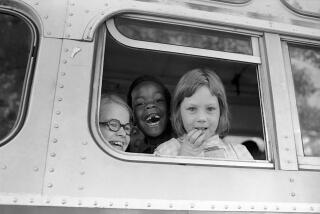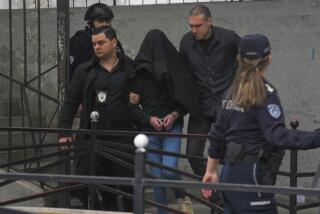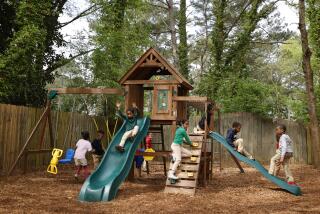Bosnia’s schools a study in intolerance
- Share via
STOLAC, BOSNIA-HERZEGOVINA — It’s shortly after noon, and teenagers who were taught their capital is Zagreb, in neighboring Croatia, are streaming out of Stolac High School. In an hour, their classrooms will be filled with children who have learned that their capital is Sarajevo, Bosnia-Herzegovina.
Fourteen years after the end of Bosnia’s 1992-95 war, youngsters from Bosnian Muslim and Roman Catholic Croat families attend the same schools, but are separated from each other and learn from different textbooks.
With the Bosnian Serbs already holed up in their own part of the country, critics say the Balkan nation’s school system is one of the worst examples of segregation in Europe -- one that’s producing a generation ripe for manipulation by nationalists.
Bosnia is home to just 3.5 million people, yet its schools are governed by 14 ministries, many run by people who favor segregation.
Vedran Zubic, a high school teacher in Sarajevo, sees the separation as a continuation of wartime nationalist rhetoric.
“We have a generation of young, intolerant, ethnically isolated and ethnically overfed pupils who are being used as weapons of nationalist politicians,” he said.
The Stolac school is an example of Bosnia’s postwar emphasis on “two schools under one roof.”
It was designed by the Organization for Security and Cooperation in Europe as an urgent but temporary response to the problem of educating the children of parents who had ventured back to their prewar homes in towns subjected to “ethnic cleansing.”
During the war, Croats drove the majority Bosnian population out of Stolac, a southeastern town near the Croatian border. Those who returned found the town’s schools were using Croatian history books.
Bosnian Croats are taught that they are members of the Croatian nation living in a Croat province in Bosnia. Almost 99% of Bosnian Croats have Croatian passports and vote in Croatian elections.
Before the former Yugoslavia crumbled in the 1990s, Serbs, Croats and Bosnians attended school together and studied from uniform textbooks distributed by the communist government.
But the war opened a chasm between Bosnia’s ethnic groups, and the peace accords that followed split the country into a Serb mini-state and a Bosnian-Croat federation. Separation since has become a way of life.
Unwilling to have their kids learn the history and language of a neighboring country, Bosnian returnees formed a school for their children in a private home where Bosnian language and history was taught.
Predominantly Bosnian Muslims, for example, have been taught in geography books that “Muslims don’t attack sacred objects, unlike others,” while mainly Catholic Croats learned that “Muslims are an ethnic group and not a religion.”
The OSCE mission in Bosnia, in charge of overseeing education, pressed Croat school managers to allow the Bosnians to use the school building at least in the afternoon. The first day, Croat school staff piled up chairs and desks to build a barrier separating the children.
The U.S. Embassy in Bosnia even invited Martin Luther King III, the son of slain civil rights leader Martin Luther King Jr., to talk to teachers and students about human rights and segregation.
But in Stolac, King found, his father’s famous dream remains just that: a dream. As he spoke, Croat students sat up front; Bosnians took the chairs in the back.
Merima Tabakovic, a 17-year-old Bosnian student, points to flagrant examples of discrimination in Stolac’s classrooms: She said Bosnian students cannot enter the school before the afternoon, even if it’s raining.
“In the winter, they switch off the heating as soon as the second shift starts,” added another student, Azra Isakovic. And students rarely broach the issue of segregation with one another.
“It’s taboo,” she said.
Claude Kieffer, who runs the OSCE education department, said it was supposed to be a temporary solution until a new, countrywide curriculum was adopted.
But that never happened, and the Stolac model spread throughout the part of the country shared by Bosnian and Croats. Today, more than 50 schools operate like this.
Now, nongovernmental organizations and the OSCE are urging an end to segregation. Education, they contend, should have been a part of the Dayton peace agreement that ended the war, but in 1995, few understood the damage that segregated schools could inflict in the long run.
“The absence of genuine education reform designed to bring future citizens together undermines all other reforms so far,” Kieffer said. The system, he added, is producing “three sets of citizens who do not know anything about the others, have no intercultural skills.”
He warns: “In the longer term, this may contribute to the breakup of the country.”
David Skinner of Save the Children says about half of all peace pacts worldwide fail after five years because neglected school systems don’t produce citizens with critical thinking skills. The nonprofit group recently organized an international conference in Sarajevo where participants urged the United Nations to include education in future peace agreements.
That way, Skinner said, “we can start reducing the number of peace agreements that fail.”
More to Read
Sign up for Essential California
The most important California stories and recommendations in your inbox every morning.
You may occasionally receive promotional content from the Los Angeles Times.










